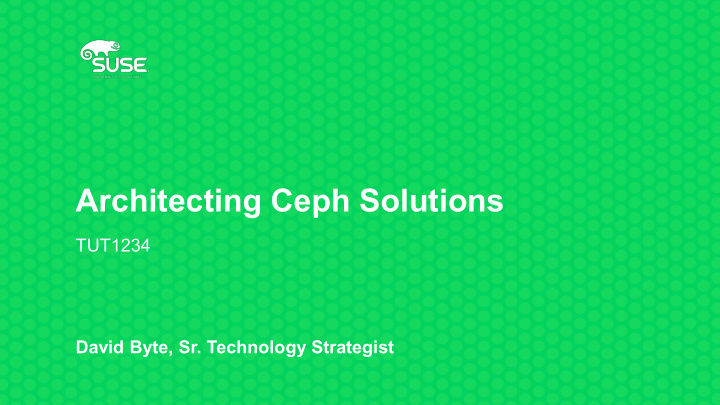



Architecting Ceph Solutions TUT1234 David Byte, Sr. Technology Strategist
Agenda Discuss SUSE goals, process, and artifacts Discuss some key considerations in designing a solution Rules of thumb
SUSE Goals General: Enable enterprise customers to effectively leverage open source technologies in ways that benefit their business. Storage Specific: Provide step-by-step guides to facilitate implementation of Ceph technologies in enterprise environments.
SUSE Solution Designs The goal for storage designs is to create the building blocks Hardware implementation guide + SUSE Product(s) + Application integration guides
Hardware Guides for SUSE Products Implementation Guides ● Hardware settings ○ Including screenshots ○ Storage controller settings ○ Firmware ● Documented process ○ Network design ○ OS install ○ SUSE Enterprise Storage install ● Performance baseline where applicable
SUSE Software Guides Document beginning state including pre-reqs e.g. Gateways required Work done to understand the I/O patterns and recommend proper configuration Discussion of storage options and how they affect software implementation Screenshots and step-by-step implementation process
The Process Work with partner to define solution design Get access to hardware Work through hardware config and software config taking screen shots & copious notes Write the doc Walk through through the document making corrections Publish Periodically, review and update
So… Where are the guides?
Architecting Clusters
Understanding Storage Needs Capacity Performance Requirements I/O Patterns Data Protection Client Access Methods
Understand Ceph Architecture
Confused About Media Types
What Should I Choose? Ceph clusters can use all varieties of storage Spinning Rust or SSD? SATA, SAS, NVMe, etc? Ceph is designed for aggregate throughput, not low latency IOPS At least for today…. And for goodness sakes, don’t use consumer devices
Evils of Expanders Bus expanders are common in more storage dense chassis The more dense the chassis, the greater the chance that the channels get bottlenecked Mixing device speeds on an expander is a bad idea
Net What???
Speed Matters 10Gb of front-end throughput means you need to plan 30+Gb for the cluster network Latency IS the enemy ● LAN ● MAN ● WAN
Differences What is the difference between 5 10Gb connections in a bond and a single 50Gb? Load balancing - most load balancing algorithms still limit a single stream to a single link of b/w Cabling Complexity - fewer cables is generally better Signaling Rate - ● 10 & 40 share the same signaling rate ● 25, 50, 100 also share the same rate, 2.5 times faster than 10 $/Port ● (Switch + NIC cost x Switch port count + Cable)/(NIC port + Switch port * Port count)
Topology Choices Hub-Spoke Ring Mesh Leaf & Spine Green Spine Switch Management for Datacenter Networks - Scientific Figure on ResearchGate. Available from: https://www.researchgate.net/figure/The- Spine-Leaf-Topology-5_fig13_305175609 [accessed 22 Mar, 2019]
Switching Mistakes Blocking Not enough uplink Are they members? Jumbo is good, usually….
Protocol Gateways Basically undoing Ceph’s aggregated advantage
Yes , Yes, YES! ● SUSE YES certified hardware provides the best support experience ● Two Levels ○ 1: SLES YES Certification - Base level ○ 2: SES YES Certification – The cluster has been tested as a whole with some fault injection 21
Processors We support 64-bit ARM & X86_64 ● AMD, Ampere, Huaweii, Intel, Marvell, etc For spinning storage ● 1x 2GHz thread per device For SSD ● 1-2x 2GHz threads per device NVME ● 2-4x 2GHz threads per device
RAM Default Values ● spinning=1GB cache per dev ● SSD=3GB cache per dev Unofficial RAM sizing ● # of OSDs * (2+cache) + 16 rounded up to next logical multiple Logical multiple = ram channels per socket * number of occupied sockets * ram chip size
Network Always be redundant (switches and NIC ports) Cluster network traffic = 3x public To figure out your size, take the amount of max public throughput per node and multiply by 4. Example: ● Expected 10Gb public traffic x 4 = 40Gb of required network ● 2x 40Gb connections (failover bond), 2x 25Gb connections (LACP_, 4x 10Gb connections (LACP)
Performance of Storage Devices 7.2k SATA < 7.2k SAS < 10k SAS < SATA SSD < SAS SSD < NVME Delivered perf in a 3x replica Luminous cluster: 7.2k SATA ~ 30MB/s per device 10k SAS ~ 45MB/s per device SATA SSD ~120 MB/s per device ** YMMV, No Guarantees or Warranty implied or otherwise 26
Pulling it Together Lots to consider when architecting a solution Think about tomorrow as well as today Make sure you take the workload requirements into account If using SSDs, look at the service life and create a maintenance program Engage with SUSE & Partner SE/SA(s) Make sure Ceph is the right tool for the job 27
Q & A 28
Thank You! 29

Recommend
More recommend